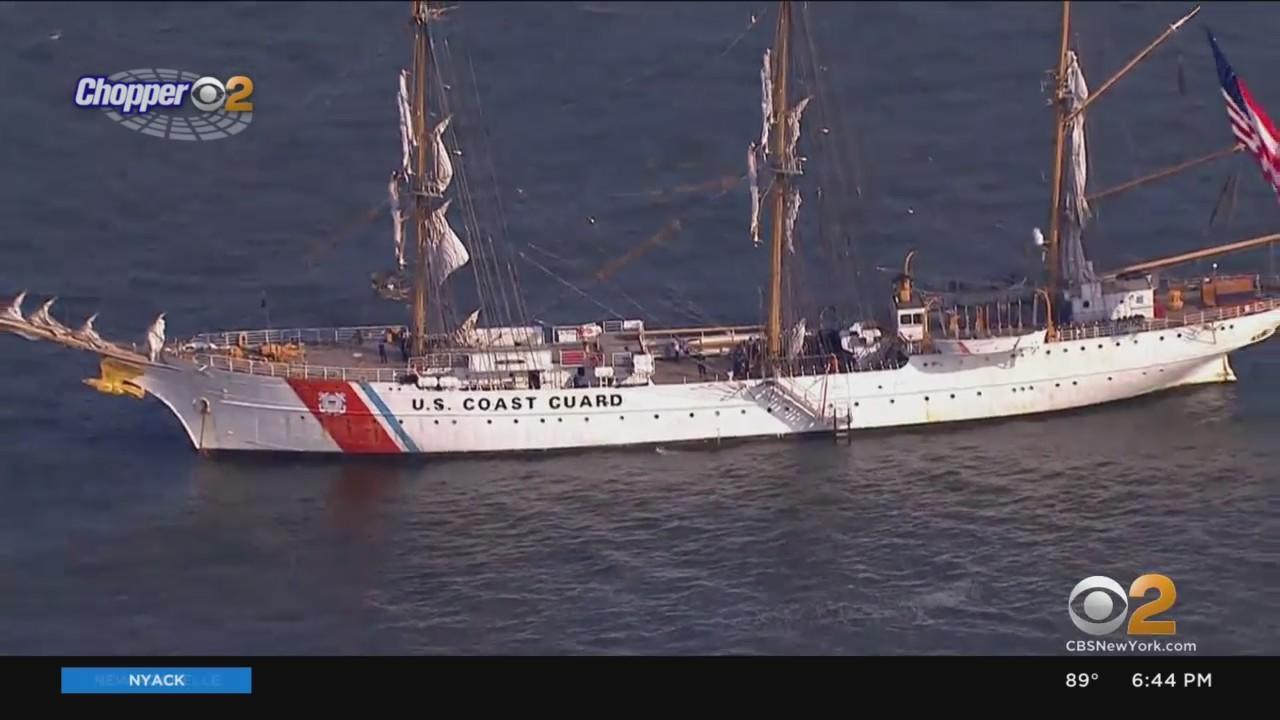Uscg Eagle History - USCGC Eagle in full sail in 2013 in the Caribbean. Photo courtesy of the US Coast Guard.
USCGC Eagle (WIX-327), formerly Horst Wessel and also known as Barque Eagle, is a 295-foot (90 m) barge used as a training cutter for future United States Coast Guard officers. She is one of only two active sailing ships in the US Navy today, along with the USS Constitution, docked in Boston Harbor. It is the seventh Coast Guard to carry the name in a line dating back to 1792, including the Revue Cutter Eagle.
Uscg Eagle History

Each summer, Eagle sends members to the U.S. Coast Guard Academy and Officer Candidate School candidates for periods ranging from one week to two months. These tours serve many functions. The primary role is to train instructor and officer candidates, but the ship also serves a public relations role for the Coast Guard and the United States. Eagle often stops at foreign ports as a goodwill ambassador.
The Long Blue Line: Danmark—the Friend Ship Between Denmark And The Coast Guard > United States Coast Guard > My Coast Guard News
The ship was built as the German sail training ship Horst Wessel in 1936; it was used to train German sailors in sailing techniques until it was decommissioned at the start of World War II. The ship received anti-aircraft weapons and was commissioned again in 1942. At the end of the war, the Horst Wessel was taken over by the United States as war reparations.
Eagle originated in Nazi Germany as a Horst Wessel, Gorch Fock class vessel. The Horst Wessel was an improvement over the original design. It was larger in size and its spans were all steel, unlike Gorch Fock's wooden yards. SSS Horst Wessel began life as Schiff ("ship") 508 at Blohm & Voss in Hamburg, Germany in 1936.
Her keel was laid on 15 February, launched on 13 June, completed on 16 September and launched on 17 September. She was the second ship of the class to be built, following the namesake of the Gorch Fock class. Rudolf Hess gave her launch speech in front of Adolf Hitler and Horst Wessels' mother christened the new ship with a bottle of champagne.
The name was given in honor of SA leader Horst Wessel, who had been martyred by the Nazi Party. He also wrote the song that became known as the "Horst-Wessel-Lied", which was later used as the national anthem of the Nazi Party. Shortly after work began on the Horst Wessel, the Blohm & Voss shipyard laid the keel for the German battleship Bismarck, designated Schiff 509.
Johnson & Towers And Uscgc Eagle
SSS Horst Wessel served as the flagship of the Kriegsmarine's sail training fleet, which consisted of Gorch Fock, Albert Leo Schlageter and Horst Wessel. (Mircea was also built in 1937 for the Romanian Navy, and work began on a fifth vessel named Herbert Norkus, but was halted at the outbreak of war.) Horst Wessel was commanded by Captain August Thiele, ex-Captain Gorch Fock, and transported. to Kiel. In the three years leading up to World War II, she made numerous training cruises in the North Atlantic, sailing with groups of trainees consisting of both future officers and petty officers. On August 21, 1938, Adolf Hitler visited the ship and sailed for about an hour before departing. Later that year, Horst Wessel and Albert Leo Schlageter took a four-month trip to the Caribbean and visited St. Thomas and Vezuela. Along the way they caught numerous sharks and sea turtles and kept the ducks on deck to provide fresh eggs.
Horst Wessel was decommissioned in 1939 at the start of World War II, but served as a training ship docked at Stralsund for the Hitler Youth Naval Division until she was recommissioned as an active naval training ship in 1942. Numerous guns were mounted along the ship. decks, including two 20mm anti-aircraft guns on the bridge wings, two on the forward deck and two 20mm Flakvierling quad mounts mm in the waist. From late 1942 to early 1945 she sailed on numerous training missions to the Baltic with cadets fresh from basic training. On 14 November 1944, escorted by Albert Leo Schlageter, Horst Wessel was sailing in bad weather when, near the island of Rüg, Albert Leo Schlageter struck a mine which caused extensive damage to her starboard bow. Horst Wessel took the Albert Leo Schlageter with a stern tug to keep her from running aground until larger ships could arrive the next day to help.
In April 1945, after the departure of the last group of German cadets, the Horst Wessel left Rüg with a group of German refugees on board. He sailed to Flsburg, where Kapitänleutnant Barthold Schnibbe surrendered to the British and the ship hoisted the Union Jack. Horst Wessel was ordered to Bremerhav and tied up to a temporary dock and stripped of much of her equipment. At the end of World War II, the four remaining German sailing ships were distributed to various nations as war reparations. Horst Wessel won the United States in a sweepstakes with the Soviet and British navies and was requested by the command of the United States Coast Guard Academy.

On 15 May 1946, CDR Gordon McGowan commissioned her into the US Coast Guard as the US Coast Guard Cutter Eagle.
File:uscg Eagle, San Diego Bay.jpg
In June 1946, a US Coast Guard crew sailed her from Bremerhavn to Orangeburg, New York through a hurricane with the assistance of Kapitänleutnant Schnibbe and many of her crew still aboard. A crew of German volunteers was disembarked at Camp Shanks and the Eagle proceeded to a new home port in New London, Connecticut.
Training at sea on a sailing ship has always been part of the Coast Guard School's curriculum. In 1877, the first cadets to roll in the U.S. Cutter Revue Service, the forerunner of the U.S. Coast Guard, completed their training aboard Revue Cutter James C. Dobbin. In 1878 James C. Dobbin was replaced by Revue Cutter Salmon P. Chase. Cadets lived aboard the ships (physical classrooms did not come ashore until the 1900s), held classes aboard in the winter, docked in New Bedford, Massachusetts or Arundel Cove, Maryland, and sailed for deployment training in the summer. . During this time, Salmon P. Chase made numerous trips to Europe. From 1890 to 1894, Salmon P. Chase ceased operations due to a surplus of US Naval Academy graduates. In 1907, Salmon P. Chase was discharged and transferred to the Marine Hospital Service.
In 1922, Itasca was determined to be too small for the Cadet Corps and was decommissioned and destroyed. She was replaced by the three-masted barque Alexander Hamilton, a former Spanish-American gunboat.
Alexander Hamilton worked at the Coast Guard Academy until 1930; after her retirement in 1944, Alexander Hamilton's main flagpole was returned to New London and served as the academy's flagpole until 1954.
United States Coast Guard Uscg Eagle Tall Model Ship 7\
In the 1930s, the Academy did not have a sailing ship for teacher training. In 1939, the Danish Navy's sail training ship Denmark was in New York City to participate in the 1939 World's Fair. After the outbreak of World War II, the ship was offered to the United States government and transferred to the Coast Guard Academy where she was. chartered as USCGC Danmark and served as a trainer training ship until 26 September 1945 when she was returned to the Danish government. .
Sailing training during these early years of the Coast Guard School is remarkably similar to what is now aboard the Eagle. A contemporary in 1886 described the training experience aboard the Salmon P. Chase as follows:
[A cadet] has a taste for the hardest and most difficult duties at the threshold of his company, which results in a fairly thorough test of his metal [sic], and if a man is really unfit for sea, physically or otherwise, that fact immediately surfaces and giving him a chance to go back to the beginning of a career that he probably wouldn't be successful at. The cadets are arranged in watches, and are in that capacity under the instructions of the chief of the deck, and must write the observations in a rough journal, carefully observe the making and receiving of all sails, in order to study the various developments of the ship. . The purpose is to impress upon them the duties and responsibilities of deck officers, and it is provided that the strictest obedience to every detail is enjoined. Knotting, splicing, mat-making, and learning the nomenclature of the various parts of the hull and masts, and the names and uses of ropes and sails, are among the first lessons in sailing, and during quiet hours the gear is readjusted and stepped on. Cadets are constantly practicing hoisting clippers, raising masts, reefing, furling and moving sails,

Uscg eagle, uscg barque eagle, uscg eagle model, uscg barque eagle history, uscg eagle schedule, uscg eagle ship, uscg eagle pictures, uscg history, jeep golden eagle history, uscg cutter eagle, uscg eagle model kit, eagle history

0 Comments